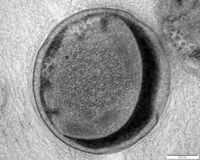Colony collapse disorder
Background
Colony collapse disorder (CCD) is a poorly understood phenomenon where large-scale, unexplained losses of adult worker honey bee colonies result in the bee colony. As of today, it is believed that many factors together is contributing to the underlying cause of the phenomenon. [6][10]. The phenomenon is often coupled with abnormal decrease in bee population and could be identified throughout the history of bee keeping. The phenomenon has been associated to various names including autumn collapse, spring dwindle, disappearing disease, May disease, and fall dwindle disease. However, the phenomenon was renamed as colony collapse disorder in late 2006 after considering previous names was not reflecting the nature of the condition. [6]. Recent studies have tried to link microbial contributions to this phenomenon. Virus such as Israeli acute paralysis virus and Kashmir bee virus have been suspected to play an important role in this phenomenon. [6].
Characteristics
1. Rapid loss of adult workers bees and large amounts of capped brood within the colony.
The bodies of the dead bees are not found in the colonies or in front of the colonies.[6]
2. Food storage are present, both honey and bee bread.[6]
3. Queen bee is present. A colony cannot be classified as suffering CCD if the queen is not found within the colony.
Rather, the colony dying because there is no queen, which is not considered CCD.[6]
4. There is no damaging levels of the mite Varroa destructor and/or the Nosema spp.
at the time of collapse, and there is a delayed invasion by other hive parasite. [6]

